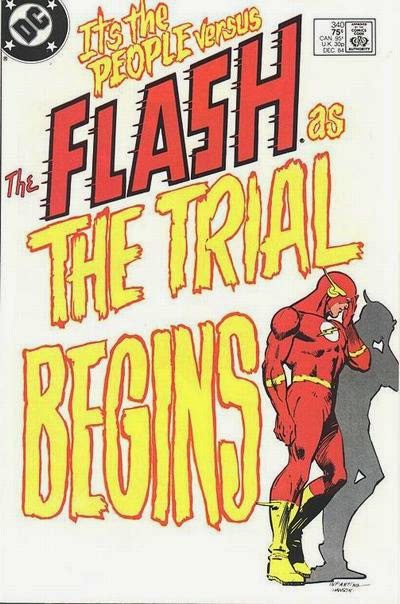Barry Allen is, or was, one of the
most wholesome characters in superhero comics.
He had a buzzcut, married his sweetheart, Iris Allen, was a
criminologist with the Central City police department, and after witnessing his
future nephew’s unexpected transformation into a speedster like him, agreed to
take on the mentorship of Wally West, who would eventually (in a previous,
better continuity) inherit the mantle of the Flash. As a child with an overly romanticized view
of the world, the character of Barry Allen really spoke to me. He was a hero with a strong moral code, one who
was easy to look up to.
The first Flash comic I picked up
was #336. This issue fell smack in the
middle of the overlong “Trial of the Flash” storyline – written by Cary Bates,
with art by Carmine Infantino – and slightly more than a year out from the
book’s cancellation. I only had a little
while to become acclimated to Barry Allen, in his own book, before he walked
off into the sunset with Iris (who had died, but came back from the future to
help absolve Barry of his murder conviction for allegedly killing the Reverse
Flash, when the rogue threatened to kill Barry’s soon-to-be second wife, Fiona Webb,
on their wedding day – yeah, it’s convoluted; it’s time travel in comic books; but
it’s so damn fun).
Those last fifteen issues were
enough to solidify my appreciation of the Flash, as a character. But the book that locked it down was Crisis
on Infinite Earths #8. When this
series is discussed, the much-homaged cover and the sacrifice of Supergirl from
issue #7 is a primary point of discussion.
It’s the one that really shocked readers. But I find the following issue to be far more
powerful. Throughout the first seven
issues of Crisis, readers, and
heroes, caught fleeting glimpses of the Flash, ghostly images the even unnerved
Batman. It’s a mystery that does not get
solved until the eighth issue.
In issue #8, “A Flash of the
Lightning!,” the anti-Monitor’s ultimate weapon, an anti-matter cannon that
will destroy the five remaining positive matter universes, is revealed to the
Flash, who has been kept incapacitated on the planet Qward by the Psycho
Pirate’s mood-changing powers. Barry
understands the gravity of the situation and the fact that he is the only hero
who can possibly stop this attack. Using
his strong force of will, the Flash builds up superspeed and escapes from the
gelatinous shackles with which he’s been held.
Immediately, he drives for the Psycho Pirate, laying him out with one
superspeed punch, and rushes the “pirate” from Thunderer to Thunderer, causing the
guards to fear and hate their master.
When they attack the anti-Monitor, Barry rushes for the cannon to
examine it (his scientific background coming in handy), recognizes its power
source as concentrated anti-matter, and realizes he must run against the flow
of that anti-matter to force the energies back into the cannon, in order to
destroy it.
He also understands that he will
most likely die, if he does this.
Without hesitation, the Flash jumps into the cannon. And he starts to run.
Racing against time, pushing beyond
anything he’s ever experienced, Barry Allen’s life rushes across his vision. But this is no hallucination or spiritual
journey – Barry is running so fast that he is actually going back through
time. The images – the friends he sees
for the last time – are paralleled by those earlier instances where Batman and
others saw the “ghost” of the Flash.
It’s overwhelming and emotional for this man who only ever wanted to do
good and come home to his one true love, Iris.
As he passes through his life, the Flash destroys the cannon, crushes
the Anti-Monitor’s plan, and saves reality.
And Barry Allen dies, alone and
unmourned.
This issue hit me so hard, as a
kid. And for a very long time, the death
of the Flash was one of the handful of “deaths” in comics that was
irrevocable. Because of that, the
character of Barry Allen’s Flash cast a long shadow over the heroes of the DC
universe, none moreso than Wally West, who would take up the mantle soon after
the “Crisis” passed.
But that’s an entry for another
day.
-chris












No comments:
Post a Comment